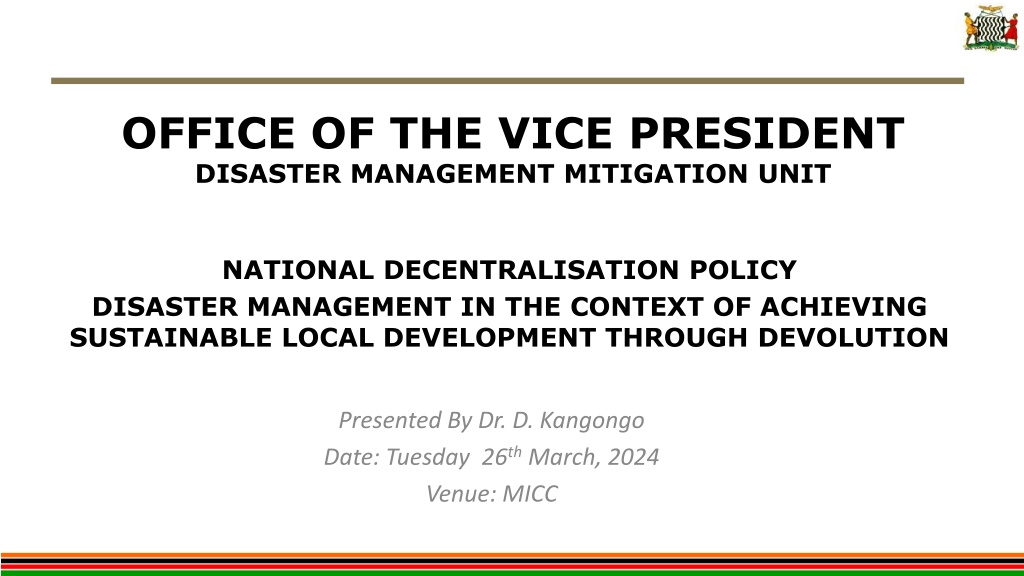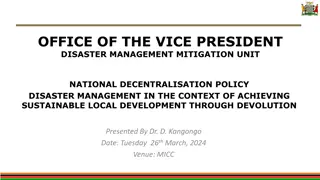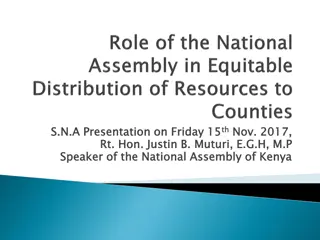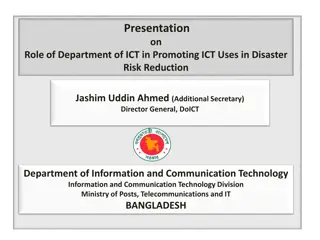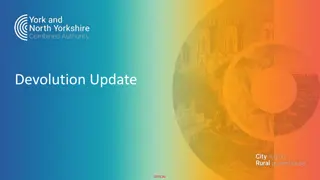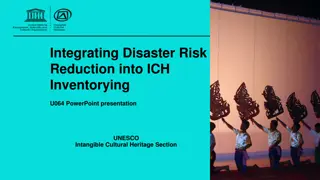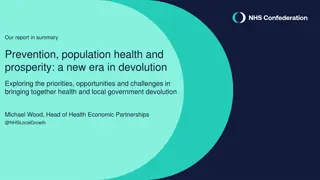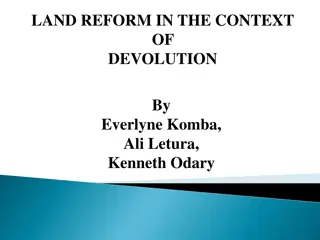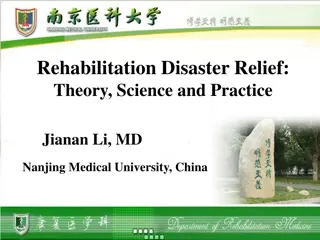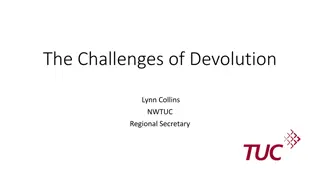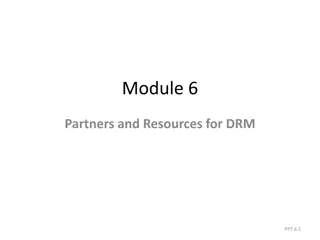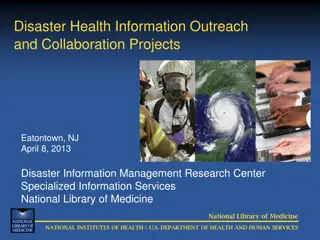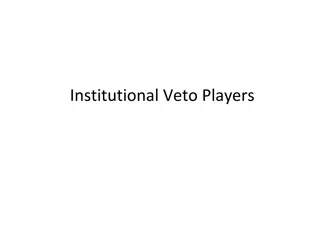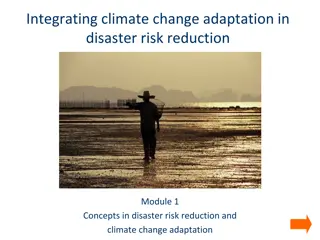Disaster Management and Local Development Through Devolution
The presentation outlined the importance of disaster management in the context of achieving sustainable local development through devolution. It emphasized the need for effective subnational planning, mainstreaming of disaster risk reduction, and financing for disaster relief. The concept of devolution of authority to local units was highlighted as crucial for managing local risks and resources. The disaster-development nexus was discussed, emphasizing the interrelated dimensions between disasters and development. Overall, the presentation underscored the significance of empowering subnational structures to manage disaster risks effectively.
Download Presentation

Please find below an Image/Link to download the presentation.
The content on the website is provided AS IS for your information and personal use only. It may not be sold, licensed, or shared on other websites without obtaining consent from the author. Download presentation by click this link. If you encounter any issues during the download, it is possible that the publisher has removed the file from their server.
E N D
Presentation Transcript
OFFICE OF THE VICE PRESIDENT DISASTER MANAGEMENT MITIGATION UNIT NATIONAL DECENTRALISATION POLICY DISASTER MANAGEMENT IN THE CONTEXT OF ACHIEVING SUSTAINABLE LOCAL DEVELOPMENT THROUGH DEVOLUTION Presented By Dr. D. Kangongo Date: Tuesday 26th March, 2024 Venue: MICC
PRESENTATION OUTLINE 1.Introduction 2.Disaster Management in the Subnational Planning; 3.Subnational Mainstreaming of Disaster Risk Reduction (DRM) 4.Mainstreaming Disaster Risk Reduction 5.Guidelines for Subnational Mainstreaming 6.Disaster Risk Reduction in Urban Areas 7.Financing for Disaster Relief, Early Recovery and Reconstruction 8.Conclusion 2
INTRODUCTION Development is broadly defined as improvement in a country s economic and social conditions. It refers to improvements in ways of managing natural and human resources to create wealth and improve people s lives. It has economic, social and human dimensions that are closely interrelated. Economic development is a measure of how wealthy a country is and of how this wealth is generated and distributed. Economic growth, gross domestic product (GDP) generally and per capita and poverty levels are the common indicators of economic development. Sustainable development is development that meets the needs of the present without compromising the ability of future generations to meet their own needs (UNWCED, 1987). 3
CONT Devolution of authority and resources to the local units are functional necessities because the subnational entities are so dispersed geographically that central directions do not reach them quickly. Central governments have delegated powers, responsibilities and resources to the local administrative units to manage the local risks and resources. 4
CONT Disaster-development nexus Disasters erode hard-earned gains of development and further impede the process of development. Disasters have a close connection with development. This nexus has three separate but interrelated dimensions: disasters erode gains of development; deficits in development create risks of disasters; and development creates new risks of disasters that compound the existing layers of risk. 5
2. DISASTER MANAGEMENT IN THE SUBNATIONAL PLANNING To be effective, national-level strategy planning and guidelines and sectoral level guidelines for mainstreaming DRR within development must strengthen provincial, district and satellites. Provincial governments should work with national governments on disaster management. Subnational structures should therefore, be vested with powers and authorities to manage their risk of disasters, with material and financial assistance from the national government as may be necessary. Because many provincial governments are large in terms of areas or population, further devolution of powers and authority to the districts and other local authorities are crucial for the effective mainstreaming of DRR within development. Such devolution, however, is not always forthcoming. 6
CONT In the context of the country s growing urbanization, it is the city governments that are supposed to control many critical development activities especially considering they cover almost half the population of the region. Municipal authorities also must be vested with powers, authority and capacities to mainstream DRR within development programmes, activities and projects. 7
3. SUBNATIONAL MAINSTREAMING OF DISASTER RISK REDUCTION (DRM) Subnational and local-level planning and development make sense because local governments and individuals are best aware of their hazards, vulnerabilities and risks and can plan their resources for the managing those risks in a more efficient manner than can central planning and regulation. More and more national governments around the world are appreciating the importance of subnational planning and governance for the effective management of disaster related risks. The dominant theoretical framework that has emerged is the principle of subsidiary, which means that local tasks are best managed if important decisions are taken as close as possible to the people who will be affected. 8
CONT This makes the decisions better informed, inclusive and participatory, and the quality of governance improves. The concept of community-based disaster preparedness has been successfully implemented by national and international NGOs in developing countries all around the world. 9
CONT. There is need to develop Mult-hazard risk maps for all provinces, districts and municipalities of the country, based on assessed hazards, vulnerabilities and capacities. This information can be used to produce a composite Disaster Risk Index of Zambia. Zambia, therefore, should institutionalize the process of DRR mainstreaming into its sectoral and local development plans.The legal mandates for the preparation of district and sub-district disaster management plans in many countries has created opportunity for mainstreaming DRR within local development planning, but in the absence of systematic guidelines, the opportunities have hardly been utilized. 10
4. MAINSTREAMINING DISASTER RISK REDUCTION While Disaster Management is important in the management of disasters, it has been criticized for being reactive as opposed to proactivity. As a result, following the adoption of the SENDAI Framework, many nations have prioritized Disaster Risk Reduction as it is proactive and cost-efficient. As DMMU, we encourage all players in the disaster risk sector to practice DRR as opposed to the Disaster management. DMMU has decentralized its operations through the recruitment of District Disaster Management Officers (DDMOs) and the Regional Coordinators. Coordinators at both the district and province work with other stakeholders in district and provinces thereby improving the operations. 11
5. GUIDELINES FOR SUBNATIONAL MAINSTREAMING Given clear mandates, resources and capacities, mainstreaming may work effectively for local-level planning and development for the same reasons the principle of subsidiary has been advanced for inclusive and effective governance. First, local people have a better understanding and appreciation of their hazards, vulnerabilities, capacities and risks. Second, local authorities can better plan and implement location-specific programmes, activities and projects that can mitigate the risks of local disasters in a cost-effective manner. Local leadership can better coordinate with different development sectors for mainstreaming DRR within all existing programmes, activities and projects. 12
CONT. Local leadership can also mobilize local resources to supplement resources from the national and provincial governments, and they can prioritize investment of such resources for optimal use for development that is sustainable and resilient. Local communities have intimate knowledge of their risks, resources and needs, which must feed into the national policies and planning. This two-way process of development makes mainstreaming of DRR both top-down and bottom-up with national policies, planning, guidelines and resources informed by local-level risks, capacities and need. 13
6. DISASTER RISK REDUCTION IN URBAN AREAS In the context of burgeoning urban risks of disasters due to the rapid and unplanned growth of cities and increasing exposure of people and their built environment to natural and human-made hazards, particularly in developing countries, the mainstreaming of DRR within development assumes importance for building up the resilience of cities. Most cities have a master plan, and many cities have detailed zonal plans and zoning regulations that defines the purpose for which an area can be used, such as commercial, residential, institutional, recreational, city forests or park. Preparation and revision of these plans provide good entry points to study the physical characteristics of the land, such as location, elevation, geological composition, soil characteristics, availability of surface and sub-soil water and natural hazards, and then factor that data into the preparation of a land-use 14 plan.
CONT Preparation and revision of these plans provide good entry points to study the physical characteristics of the land, such as location, elevation, geological composition, soil characteristics, availability of surface and sub-soil water and natural hazards, and then factor that data into the preparation of a land-use plan. Risk-sensitive land-use planning implies using land for the purposes that will reduce the risks of disasters or at least will not aggravate such risks. For example, low-lying areas and food plains will not be used for construction and areas prone to liquefaction will not be used for high-rise building. 15
CONT Preparation and revision of these plans provide good entry points to study the physical characteristics of the land, such as location, elevation, geological composition, soil characteristics, availability of surface and sub-soil water and natural hazards, and then factor that data into the preparation of a land-use plan. Risk-sensitive land-use planning implies using land for the purposes that will reduce the risks of disasters or at least will not aggravate such risks. For example, low-lying areas and food plains will not be used for construction and areas prone to liquefaction will not be used for high-rise building. 16
CONT. When enforcement is weak due to poor governance or corruption, a collateral mechanism of independent inspections by the housing credit and insurance agencies may push better compliance with building codes. Similarly, better awareness and information about building safety will generate demand for safer houses, which will put pressure on builders to comply with the codes. These are multifarious tasks that provide entry points for DRR in urban local areas. Nevertheless, there is wide consensus that there is inadequate investment in DRR, a view echoed by government officials actively engaged in securing DRR This underinvestment can often be traced back to the simple fact that policy makers favor investments that generate immediate, tangible outcomes rather than risk reduction endeavors that may not reap benefits for many years. 17
7. FINANCING FOR DISASTER RELIEF, EARLY RECOVERY AND RECONSTRUCTION Funds for post-disaster response are typically very limited relative to need. Disasters can place enormous pressure on public finance, resulting in both higher spending demands and loss of revenue as economic productivity drops. The speed with which funding can be made available relative to the sequencing with which tranches of relief, early recovery and reconstruction funding are required also needs to be considered. Governments struggle to find adequate resources to meet immediate humanitarian needs in the immediate aftermath of a disaster and to support recovery and reconstruction efforts. The recovery-development alignment is particularly critical: integrating development and recovery planning permits policy makers and planners to take advantage of the post disaster window of opportunity to initiate larger changes. 18
8. CONCLUSION (i)Development broadly defined as improvement in a country s economic and social conditions. It refers to improvements in ways of managing natural and human resources to create wealth and improve people s lives. (ii) Subnational and local-level planning and development make sense because local governments and individuals are best aware of their hazards, vulnerabilities and risks and can plan their resources for the managing those risks in a more efficient manner than can centrally planning and regulation. (iii) Local development therefore, refers to the totality of social, economic environmental transformation and its attendant impact on development in general. If mishandled, it can significantly contribute to disasters 19
CONT (iv) Economic development is a measure of how wealthy a country is and of how this wealth is generated and distributed. Economic growth, gross domestic product (GDP) generally and per capita and poverty levels are the common indicators of economic development. (v) Sustainable development is development that meets the needs of the present without compromising the ability of future generations to meet their own needs (UNWCED, 1987). 20
THANK YOU 21
